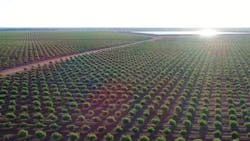AGL Energy developing Solar-Storage Microgrids for Australian Almond Farms
An Australian farming management firm is embracing renewable energy microgrids to eliminate carbon emissions from almond operations in New South Wales (NSW).
The power generator AGL Energy is partnering with Australian Farming Services (AFS) on three microgrid projects for three agricultural enterprises in Riverina, NSW. AGL is beginning construction on the first five-hectare solar array and 5.4-MWh battery energy storage microgrid system for AFS’ Cadell Orchards.
AGL is also working with the farming services firm on two more microgrids at the Canally Orchard and the Murray Downs Processing Facility. All the farms and processing facilities are focused on almond production. Completion and commercial operations on all three of the microgrids are expected in 2024.
Normally, the farms utilize diesel-powered generation for irrigation systems. Shifting the on-site power to solar and battery storage could reduce reliance on diesel by 85%, helping cut the orchards’ combined Scope 1 carbon dioxide emissions by nearly 11,000 metric tons, according to reports. Scope 1 emissions are classified as on-site, direct emissions from operations.
“AGL has been working with AFS to model energy usage and to design an integrated and innovative renewable energy system to lower their costs and meet their future needs across Cadell Orchards, Canally Orchards, and Murray Downs Processing plant,” AGL Chief Customer Officer Jo Egan said in a statement.
AFS manages more than 4,300 hectares and over 1.45 million trees across three property aggregations. Canally and Cadell Orchards are comprised of multiple cropping farms totaling thousands of hectares.
Utility-scale Distributed Energy Solutions is part of content at T&D World Live
Happening Sept. 12-14 in Sacramento
Grid Transformation for an Electrified World
“As one of the largest employers in the region, these renewable energy projects provide our businesses with greater energy price certainty and better energy reliability so we can focus on producing Australian-grown almonds,” said AFS CEO David Armstrong.
Originally announced in September 2022, the first microgrid at Cadell is expected to generate close to 5.2 GWh of low-carbon energy capacity. It includes 4.9 MW of solar to charge the battery system, with 7 kilometers of underground power lines, inverters, grid stability units, and controller systems.
The Cadell Orchard is not connected to the main grid due to its remote location.
The United States is far and away the world’s biggest producer of almonds, but Australia’s farming industry has ascended to a distant second with close to 145,000 metric tons of crop production.
According to Climate Watch, the agricultural, forestry, and land use sectors account for more than 18% of worldwide annual greenhouse gas emissions. The energy sector globally emits more than 70% of GHGs.
In the U.S., the federal Environmental Protection Agency estimates that, according to 2021 statistics, the agricultural sector generates about 10% of GHG emissions, the electric power sector totals close to 25%, and industrials emit 23%.








